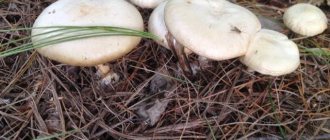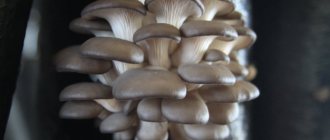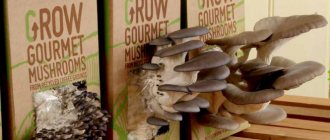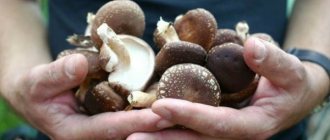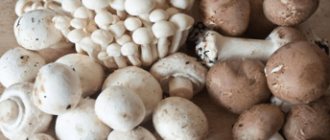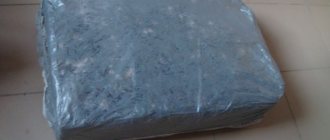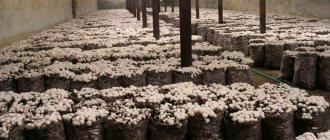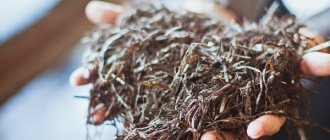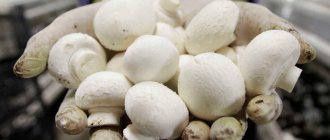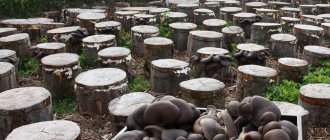Growing champignons at home is not a difficult task if you know what room is needed for this, as well as what components to use to ensure stable and high-quality fruiting. Today they use several popular methods of growing mushrooms in their home.
Selection and preparation of premises
Growing mushrooms does not require any special knowledge or skills. The best place for such a business is the basement or cellar of a private house. Mushrooms are not heat-loving and do not require constant lighting. If there is no basement, it is permissible to carry out the procedure in a greenhouse in a country house or barn.
The room must have concrete walls, cemented floors and good ventilation. Mesh material used to cover the ventilation holes will help prevent pest attacks. The walls and ceiling must be limed.
Interesting Facts
- These are the first mushrooms to be grown in an artificial environment.
- Champignons are widely used in cosmetology. Lotions and masks based on these mushrooms are great for helping with skin problems.
- This type of mushroom is used in medicine and is a good aid in the fight against bronchial pathologies and diabetes mellitus types 1 and 2.
- Champignons contain chemicals that relieve headaches, help in the treatment of hepatitis and various forms of tuberculosis.
What kind of mycelium is needed?
Mycelium is also called mycelium. It is the vegetative body of fungi - a system of thin branching threads or hyphae.
The mycelium performs important functions, therefore without it the process of growing mushrooms will not take place:
- participates in sporulation and is responsible for preserving the formed spores;
- helps organisms attach to nutrient substrates;
- adapts well to the environment;
- With the help of enzymes, it processes cellulose, obtaining from it substances available for growth and development.
Mycelium is an important organ responsible for the vegetative reproduction of organisms.
Purchasing a finished product
To grow champignons at home, it is recommended to use grain mycelium , since it is not only convenient to sow, but it does not require additional processing. When purchasing mycelium, pay attention to its appearance: the grains should be yellow with a slight orange tint.
It is not recommended to purchase mycelium with dark spots - this is evidence that mold is present. The quality of planting material is also determined by smell: there should be a clearly defined aroma of fresh mushrooms. If you notice an ammonia odor, the product was not stored properly and is spoiled.
Be sure to pay attention to the manufacturer's company. It is advisable to choose mycelium from a well-known and large supplier. You shouldn’t buy a lot of mycelium at once; it’s better to sample it first. If there are no problems with germination, the formation of mycelium will be good, then purchase a large batch.
Growing mycelium yourself
Before planting mushrooms, many gardeners and gardeners grow mycelium themselves, citing the fact that this way they will be able to obtain a high-quality product. Mycelium grown at home can be used as compost or grain.
The preparation of grain mycelium occurs according to the following scheme:
- Pour 10 kg of grains into a container, add 15 liters of water.
- Place on low heat, bring to a boil and simmer for half an hour to an hour. The grains should not be boiled, but should be soft.
- Drain the water, dry the grain, and then pour the finished material into liter jars. Make holes in the lids and beans.
- Seal the holes in the lids with cotton swabs. Place the jars in an autoclave with a pressure of 1.5 atm. for 30 minutes.
- Place the mycelium in the cooled grain, or rather in its holes.
- Place the jars in a thermostat with a temperature of 24 degrees, do not remove them until the mycelium completely occupies the entire nutrient medium.
To obtain compost mycelium, the following procedures are performed:
- Take 3-liter jars and fill them 2/3 with champignon substrate. Compact well.
- Roll up the jars with lids, making 3-centimeter holes in them, covering them with cotton swabs.
- Heat the compost to 24 degrees, place the mycelium in it.
- Tightly sealing the holes in the lids will help prevent infection of the mycelium.
Sales of goods
All the efforts of the mushroom grower will be in vain if he cannot sell his products. Therefore, you should consider all sales options in advance:
- independently on the market;
- through market small wholesale traders;
- through chain stores;
- direct deliveries to catering enterprises;
- hand over to wholesalers-procurers.
Each method has its own price, advantages, disadvantages and opportunities, which allows the entrepreneur to make a choice and adapt to market demands, taking into account seasonal factors. The periods of waiting for the next wave of harvest should be devoted to searching for clients to conclude long-term supply agreements. However, there is always a risk of overstocking and some of the products not being sold. Such a risk can be insured with an insurance company, but it is even better to organize recycling.
Champignon does not have a pronounced aroma, like wild mushrooms. But if it is cut into slices and dried, a strong mushroom smell appears. Chefs use this technique to improve the quality of champignon dishes.
Drying champignons is acceptable, although time-consuming. In addition, dried mushrooms require storage conditions. Salting, pickling and canning will not cost a lot of labor and the possible hiring of temporary workers. An excellent solution is freezing in a chamber or freezer. Frozen mushrooms are stored for at least 1 year and are accepted for sale. But it will be necessary to deliver the goods frozen to the consumer, which will require a car with a refrigerator.
Freezing is a universal way to store mushrooms
Preparation of substrate (compost): DIY preparation
Mushrooms require conditions close to natural, so specially prepared compost is needed, the composition of which must be loose and nutritious.
To grow maximum yield, prepare the substrate following the instructions. Since the strains or varieties of mushrooms are different, the preparation technology and the composition of the substrate may vary slightly. But there are general principles for preparing compost for growing mushrooms.
To prepare compost, combine the ingredients in the following proportions:
| First option | Second option |
|
|
It is acceptable to replace horse manure with bird or cow manure, but in this case the yield will be lower.
The following follows:
- The straw is soaked for 24 hours in warm water in a convenient container. Then they are placed in a stack, mixed with layers of manure (there should be 6-8 of them). Moisten each layer with warm water.
- After 3-4 days, mix the compost well and add urea and superphosphate.
- After another 3-4 days, mix the compost again, gradually adding the remaining minerals. At the last stirring, add gypsum.
On average, it takes 24-28 days to prepare compost. The fact that the substrate is ready is indicated by the disappearance of the ammonia smell and the acquisition of a light brown hue of manure. The finished substrate is moved to the basement and placed in containers where it is planned to grow champignons.
Experienced mushroom growers recommend using compost that is less picky and more resistant to disturbances in growing conditions for the first planting. The yield with compost mycelium is not as rich, but it is much easier to get the first experience with it. Before planting the mycelium, carefully examine the substrate: it should be slightly springy, not hard and not crumbly.
A little history
Previously, wild mycelium was widely used as seedlings. Initially, it was taken from a manure dump, and when the mycelium did not want to grow at all due to poor conditions, it was grown in so-called greenhouses, which were called “exploration” greenhouses. After a certain time, all the necessary soils were planted from manure, pre-treated and prepared by specialists.
Unlike usual planting, in this case the seedlings were not sprinkled with soil. This was necessary in order to properly make the mycelium. Otherwise, fruits could form, and this was unacceptable. After the mycelium grew and penetrated the substrate from beginning to end, it was used for planting. The resulting substrate was dried so that it could be stored for more than one year.
In the 30s of the last century, champignon mycelium grown using this method was used. But in this case, mushroom pickers faced several problems: the mycelium helped to achieve only a very small harvest, while it itself disappeared. During planting, many foreign microorganisms were introduced, as a result of which the champignons had no chance to grow. In this regard, scientists have long been thinking about how to grow mushrooms differently, and were looking for different ways and options.
Success came in the 94th year of the last century, when in France researchers first obtained a pure culture. Its distinctive feature is that it was created and grown from spores using certain extracts and in a more favorable environment. Thanks to this approach, the resulting mycelium became the “progenitor” of the modern one. The spore mycelium showed excellent results. She felt great, quickly took root, grew well on compost, and began to bear fruit much earlier.
In a significant number of countries that were actively involved in the production of champignons, in the 20s there were already functioning laboratories where they produced planting material using the invented technology. The USSR soon also figured out how to grow sterile mycelium.
Step-by-step instructions for beginners
There are several basic step-by-step rules that you need to know when planting and growing mushrooms at home. If done correctly, you will be able to regularly obtain large harvests of mushrooms.
Landing
After preparing the substrate and placing it in boxes or bags, it is planted with mycelium, which is buried 5 cm. A distance of 20 cm is maintained between the depressions. It is recommended to perform landing in a checkerboard pattern. After planting, sprinkle the mycelium with soil.
If fungal spores are planted, they are sown on the surface of the soil. After sowing, there is no need to sprinkle them with soil and moisten them. The soil is covered with a cloth and moistened regularly. The mycelium grows within five days. At this time, the humidity in the room is maintained at 80-95% and temperature 22-27 degrees. After 12 days, the surface is covered with 1 part limestone, 4 parts soil and 5 parts peat. The thickness of the layer should be at least 3 cm. After this, another 5 days should pass, the soil should be periodically moistened. After another 5 days, the temperature is lowered to 13-16 degrees.
Growing and care
Although there is no need for constant care for mushrooms, it is necessary to first prepare the room and create special conditions in it:
- Growing equipment. Depends on the method of growing champignons. The best way is considered to be growing in bags. For this purpose, special supports with hangers are useful, on which bags with substrate are suspended. It is recommended to use plastic equipment - it does not deform, does not corrode, and is much cheaper.
- Optimal temperature. Champignons do not require high temperatures, therefore they do not create greenhouse conditions. You just have to insulate the room and install thermal insulation, which helps retain moisture. Heating devices must also be installed - the temperature should not fall below 13 degrees. The elevated temperature is set only at the initial stage. For additional heating, the use of infrared lamps is permitted.
- Humidity level. Champignons love moisture, so the air in the room must be constantly humidified. It's simple: use sprayers or special electronic humidifiers. The humidity level is not lower than 70-90%.
- Ventilation and lighting. Be sure to regularly ventilate the room. It is better to use hoods that deliver fresh air. But if you do not plan to grow in large volumes, it is permissible to manually ventilate the room. Several garden lamps are installed for lighting.
It is equally important to take care of fertilizer. As the mycelium grows, it gradually appears on the surface, and within a couple of weeks it will be completely above the soil. A fertile substrate poured on top will help to avoid drying out and destruction of the still fruitful mycelium. Fertilizer consisting of 9 parts peat and 1 part chalk is also added to the soil. For 1 sq. m, 40-50 g of the mixture are evenly scattered.
Harvesting Rules
From the moment of sowing to the harvest of the first harvest, 3-4 months pass. Collect young medium-sized mushrooms, those with a whole membrane that connects the stem and cap. It is recommended to collect mushrooms with heavily opened caps as seed material - they lose their beneficial properties.
It is forbidden to pick mushrooms with a darkened light brown cap - they can cause intoxication of the body and lead to severe poisoning.
Champignons are not cut off like wild mushrooms, but twisted. The hole remaining after collection is lightly sprinkled with compost. The mushroom will grow in this place again. Active fruiting of champignons lasts 8-14 weeks. During this time, the crop is harvested up to 7 times. Further, the yield decreases, so the mycelium is removed and the substrate is disposed of.
After fruiting stops, the mycelium is removed and used as food for the next generation. The remaining substrate is not reused, because it loses its fertile properties. From 1 sq. m, up to 60 kg of mushrooms are collected.
How long does it take for the crop to ripen?
The effective growth of champignons directly depends on several main factors. One of the most important factors is the room temperature.
Let us remind you that the most optimal temperature for ripening champignons is 17-24 degrees. On average, the ripening of the crop occurs in the first 3 weeks, and the next 21-24 days the fruiting bodies themselves ripen; during this period, the first champignons are usually cut.
Types of growing champignons
Champignons are grown in several ways: indoors or outdoors. Each method has its own specific requirements, compliance with which will allow you to obtain a large and high-quality harvest.
In the basement (in bags)
Experienced mushroom growers recommend using large plastic bags for growing mushrooms. This method is initially attractive because it is possible to move the bags to any place.
How the growing procedure is carried out:
- A nutrient substrate is prepared, which consists of 70% horse manure and 25% compost mixture.
- Disinfect the substrate by heating to 25 degrees.
- The mixture is placed in bags 25-30 cm thick and the mycelium is planted.
- They are left on the rack for three days, after which 5-6 slits are made in the bag and left in the dark at a temperature of 18-20 degrees.
- After 2-3 weeks, mushrooms will begin to appear in the slots. The bags are transferred to a well-ventilated and constantly lit room.
- Mushrooms gain marketable weight in about 3-4 weeks.
- After harvesting, the bags are transferred back, after which the mushroom begins to grow again.
When fruiting, you need to monitor the humidity level - it should be about 70-95%. They also monitor the temperature of the substrate – 20-27 degrees.
In the garden
To plant mushrooms, the area is prepared in the fall: the top layer of soil is removed - about 30 cm. The width of the bed should not be less than 1 meter. A distance of 55 cm is maintained between the rows. A layer of expanded clay is poured onto the bottom, serving as a drainage layer. Its thickness should be 9 cm. Weeds are thrown on top of it, watered with mullein solution, and sprinkled with soil.
Before laying the substrate on the beds, the soil is disinfected using a carbation solution. Holes are made in the substrate with a depth of at least 5 cm. The mycelium is deepened into the hole a few centimeters and sprinkled with substrate. When using grain mycelium, it is scattered over the surface of the soil and compacted. Along the border of the bed, outlets are made to drain excess moisture.
At a soil temperature of 25 degrees, the mycelium grows within 14 days. At a temperature of 30 degrees, the death of the mycelium is possible. For convenience, it is planted in a checkerboard pattern at a distance of 25 cm between the holes. After planting, the beds are mulched with straw, which promotes moisture evaporation. After the mycelium has rooted, the straw is removed and covered with a covering layer using peat and chalk in a ratio of 9:1.
On the balcony (at home on shelves)
Growing on a balcony is one of the most convenient ways, suitable for those who live in an apartment. No special physical or monetary costs are required. This procedure is quite simple:
- Glaze and insulate the balcony.
- Build a small closet with shelving, as well as drawers 20 cm high.
- Install a ventilation pipe with a damper in the cabinet, and place an air humidifier below to maintain the required level of humidity.
- To prepare the substrate, mix 10 kg of straw, 15 kg of bird droppings, and 8 kg of alabaster. The addition of superphosphate and urea - 200 g each - will increase the yield. Mix everything in warm water. The boxes are insulated with moss.
- The substrate matures in 3 weeks. After this, mycelium is added, preferably grain. It is evenly scattered on the surface of the substrate and the same layer 4-5 cm thick is poured on top. Per 1 sq. m of substrate area, 350 g of mycelium are added.
- 10 days after the mycelium germinates, it is covered with a mixture of chalk and peat in a ratio of 1:10. The thickness of the layer should not exceed 4-5 cm.
- 5 days after filling the cover soil, the air temperature is reduced to 17 degrees. The surface of the soil is regularly moistened with water.
Fruiting occurs after 50-60 days, and harvesting continues year-round.
Container method
A simple way to grow mushrooms both in the apartment and in the house. Containers with substrate can be placed in any convenient place. How to carry out the procedure:
- Prepare the container, making sure to take not only the container, but also the lid and tray.
- Disinfect the container and load the substrate.
- Sow the mycelium, deepening it to 4-5 cm.
- Moisten the soil with mycelium.
Particular attention is paid to watering. Temperature is a secondary factor, but care must be taken not to exceed 30 degrees. This method is good because 3-4 containers will be enough for your own consumption, and minimal investment will be required.
Watch a video about growing champignons in a container at home:
Block method
Many mushroom growers today prefer to buy ready-made blocks for growing mushrooms from a pressed substrate. Large production facilities press manure, peat, sawdust and seed husks into briquettes. To produce mushrooms, it is not necessary to choose premises with large areas. Due to the complete preparation of the blocks, there is no need to plant champignon mycelium in them, because it is already in them. One block weighs from 2.5 to 20 kg.
The blocks are laid horizontally on shelves and pallets, and holes are made on their surface. The burlap, film or paper with which it is covered will help prevent the block from drying out. After covering the block with mycelium, it is covered with casing soil, and ventilation is stopped. It is advisable to moisten the blocks by spraying. The first mushroom harvest is harvested after 60-75 days.
Harvesting
With good and proper care, champignon harvesting occurs within a month and a half, after planting the mushrooms.
There are also many subsequent stages of harvesting, for example, the second harvest must be harvested just 15 days after the first harvest. The average period for full ripening of the fetus is about eight weeks.
It is worth noting that champignon picking is slightly different from standard mushroom picking. Champignons cannot be cut off during collection, so they are carefully twisted out of the compost itself to avoid destroying the integrity of the covering layer. After which the holes are filled with moist soil.
What diseases and pests can cause harm?
Basic disinfection of the premises using smoke bombs, spraying and liming will help fight pests and diseases. But occasionally there are situations when mushrooms are exposed to various diseases and pests. The most common ones include:
| Name | Causes | Fighting methods |
| Fungus mite | A small yellow parasite that eats the stems of mushrooms. | Eliminate the problem by spraying mushrooms and compost with a 0.1% metaphos solution. |
| Mummies | A disease that occurs due to lack of light. The mushroom caps become dark gray and the flesh turns brown. | Remove the infected mycelium along with the substrate. |
| Mushroom midge | Fly larvae that end up in the compost along with manure. Over time, the mycelium becomes affected, which can lead to the cessation of fruiting and death. | The compost is treated with 0.5% chlorophos. |
| Rotting mushrooms | The development of the disease occurs with direct penetration of moisture into the already formed mycelium. This leads to immediate infection of other fungi. | Damaged myceliums are removed, those that remain are treated with a formaldehyde solution with a concentration of 0.2%. |
| Mold | Wet brown spots form on the surface of the mushrooms and increase in size. | Diseased mushrooms are removed, the substrate is sprinkled with superphosphate and table salt. |
Home Business Profitability
To determine the profitability of the business of growing champignons at home, you need to clearly define what you will need for full development:
- renting premises or building a new one;
- purchase of mycelium and necessary equipment (racks, containers, etc.);
- purchase of means for treating the premises;
- purchase of equipment for ventilation and air purification;
- carrying out sanitary examination of finished products.
Calculating expenses is easy. Buying 5 tons of compost will cost 5 thousand rubles, mycelium - 2.5 thousand rubles. To heat a room - about 25.5 thousand rubles. Expenses are obligatory for employees - wages for two people can cost up to 30 thousand rubles. In total, the cost part will be about 63 thousand rubles.
Calculating your profit is just as easy. From 5 tons of compost, up to 1 ton of finished products are obtained. The average cost of mushrooms is 200 rubles. From the sale of 1 ton you will be able to get 200 thousand rubles. Net profit will be 137 thousand rubles.
But such calculations do not include investments in equipment, premises and expenses that may arise during the growing process. Therefore, a mushroom picker can receive a return on costs and receive his first profit no earlier than in a year, observing all the requirements.
The following video will tell you about the nuances of growing champignons for business purposes:
Growing champignons on the territory of your house or apartment is not at all difficult if you know all the intricacies. Compliance with all requirements and conditions will help to obtain a high-quality harvest in large quantities. The use of some methods allows you to obtain crops not only for personal consumption, but also for sale.
0
0
Copy link
How to grow in containers
Champignons are also grown in containers, but this method is more commonly practiced in foreign countries (Figure 7).
Special wooden containers are used as mushroom blocks, which are treated with antiseptics against mold. This method has several significant advantages. Firstly, the substrate is in separate containers, so if it is affected by diseases or pests, it is easier to eliminate the negative consequences.
Secondly, such mushroom blocks are easier to maintain and disinfect, since the entire process can be made automatic.
Figure 7. Features of growing in containers
However, using containers for growing requires the purchase of additional equipment for servicing the mushroom blocks, so using this method at home is not economically profitable.
